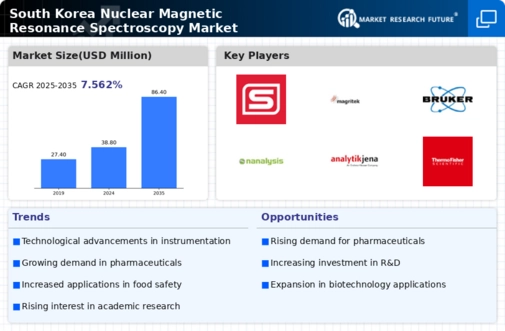Expansion of Academic Research
Academic institutions in South Korea are increasingly adopting nuclear magnetic-resonance-spectroscopy as a fundamental tool for research across various scientific disciplines. The emphasis on interdisciplinary studies has led to a surge in research initiatives that utilize this technology for applications in chemistry, biology, and materials science. With government funding supporting research projects, the nuclear magnetic-resonance-spectroscopy market is likely to benefit from enhanced academic collaboration and innovation. In 2025, it is estimated that academic research will account for approximately 30% of the total market share, underscoring the importance of this sector in driving technological advancements.
Increased Investment in Healthcare
The South Korean government is prioritizing healthcare innovation, which is likely to bolster the nuclear magnetic-resonance-spectroscopy market. With a focus on improving diagnostic capabilities and patient outcomes, investments in advanced imaging and analytical technologies are on the rise. The healthcare sector is projected to grow by 5% annually, with a significant portion allocated to diagnostic tools, including nuclear magnetic-resonance-spectroscopy. This trend indicates a shift towards personalized medicine, where precise analysis of biological samples is crucial. As healthcare facilities upgrade their equipment, the demand for nuclear magnetic-resonance-spectroscopy systems is expected to increase correspondingly.
Technological Integration in Industry
Industries in South Korea are increasingly integrating nuclear magnetic-resonance-spectroscopy into their quality control and product development processes. This integration is driven by the need for accurate and efficient analysis of materials, particularly in sectors such as food and beverage, petrochemicals, and polymers. The nuclear magnetic-resonance-spectroscopy market is likely to see a rise in adoption rates as companies recognize the benefits of real-time analysis and improved product consistency. By 2025, it is anticipated that industrial applications will contribute to approximately 25% of the market, highlighting the technology's versatility and importance across various sectors.
Rising Demand in Pharmaceutical Sector
The pharmaceutical sector in South Korea is experiencing a notable increase in demand for advanced analytical techniques, particularly in the nuclear magnetic-resonance-spectroscopy market. This demand is driven by the need for precise characterization of drug compounds and the development of new therapies. As pharmaceutical companies invest heavily in R&D, the market for nuclear magnetic-resonance-spectroscopy is projected to grow significantly. In 2025, the market is expected to reach approximately $150 million, reflecting a compound annual growth rate (CAGR) of around 8%. This growth is indicative of the increasing reliance on sophisticated analytical methods to ensure drug efficacy and safety.
Growing Awareness of Analytical Techniques
There is a growing awareness among South Korean industries regarding the advantages of advanced analytical techniques, including nuclear magnetic-resonance-spectroscopy. This awareness is fostering a shift towards adopting more sophisticated methods for quality assurance and research. As companies strive to meet international standards and enhance their competitive edge, the nuclear magnetic-resonance-spectroscopy market is likely to expand. Educational initiatives and workshops are being organized to promote understanding and utilization of this technology. By 2025, it is expected that the market will witness a growth rate of approximately 7%, driven by increased adoption across various sectors.





















Leave a Comment